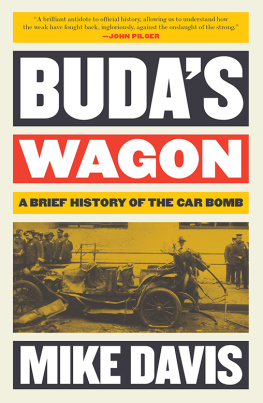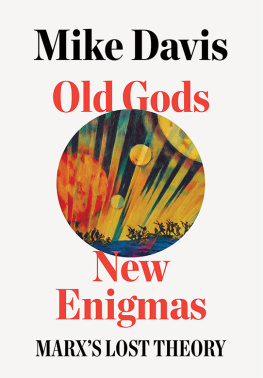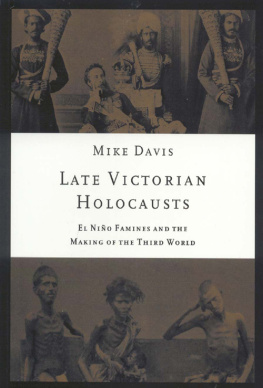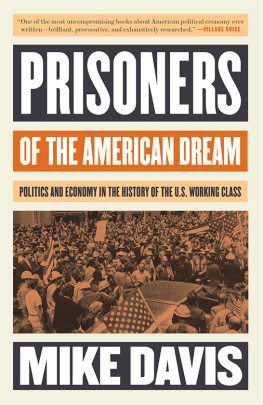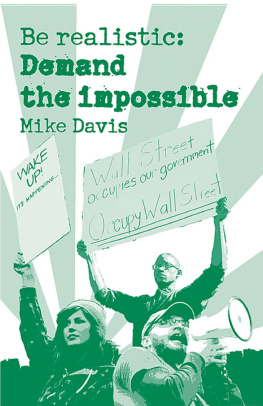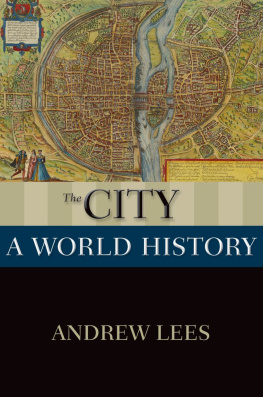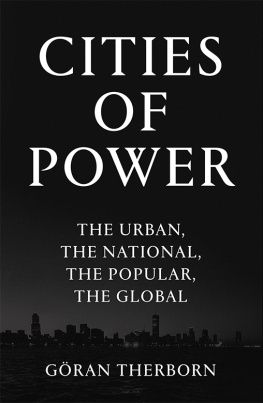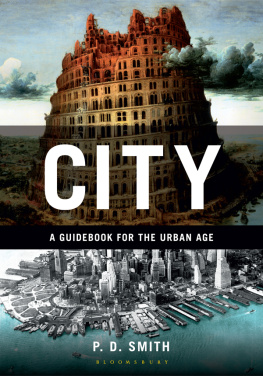A short and fascinating history of the car bomb. London Review of Books
A serious, disturbing and pessimistic book that resonates with widespread contemporary terrors An excellent analysis of the arrogant miscalculations, cruelties and sometimes wanton stupidity of various governing elites. Times Literary Supplement
Riveting, a whirlwind survey of the car bombs historical hot spots. Time Out New York
Davis small book brings home in unsparing terms the bloody past and the even bloodier future of the car bomb. Pittsburgh Post Gazette
Davis book moves quickly, painting a bone-chilling portrait of just how easy it has become to attain the information needed to build a car bomb and deploy it. Time Out Chicago
Products like iPods, brands like Coca-Cola and pop stars like Michael Jackson arent the only currency of globalization. As Mike Davis points out in this swift, grimly readable little book, weapons are too. Houston Chronicle
BUDAS WAGON
A Brief History of the Car Bomb
MIKE DAVIS

This paperback edition published by Verso 2017
First published by Verso 2007
Mike Davis 2007, 2008, 2017
All rights reserved
The moral rights of the author have been asserted
1 3 5 7 9 10 8 6 4 2
Verso
UK: 6 Meard Street, London W1F 0EG
US: 20 Jay Street, Suite 1010, Brooklyn, NY 11201
www.versobooks.com
Verso is the imprint of New Left Books
ISBN-13: 978-1-78478-663-2
ISBN-13: 978-1-78478-665-6 (US EBK)
ISBN-13: 978-1-78478-664-9 (UK EBK)
British Library Cataloguing in Publication Data
A catalogue record for this book is available from the British Library
Library of Congress Cataloging-in-Publication Data
A catalog record for this book is available from the Library of Congress
Typeset in Bembo by Hewer Text UK Ltd, Edinburgh
Printed by Scandbook AB, Sweden
To Tom Engelhardt, friend extraordinaire
Contents
| Endpapers | Z-Backscatter X-ray of car. Copyright American Science and Engineering, Inc. |
How can you sleep with death just around the corner?
Chechen warning
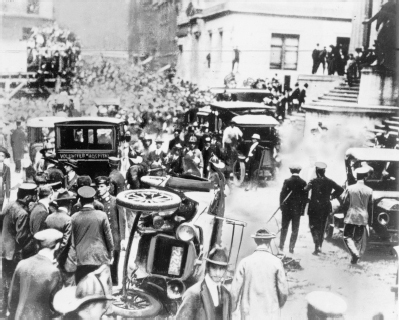
Figure 1 Mario Budas Wall Street bombing, September 1920.
You have shown no pity to us! We will do likewise. We will dynamite you!
Anarchist warning (1919)
On a warm September day in 1920, a few months after the arrest of his comrades Nicola Sacco and Bartolomeo Vanzetti (the best friends I have in America), a vengeful Italian immigrant anarchist named Mario Buda parked his horse-drawn wagon near the corner of Wall and Broad streets, next to the new federal Assay Office and directly across from J.P. Morgan and Company. The Morgan partners, including the great Thomas Lamont and Dwight Morrow (Charles Lindberghs future father-in-law), were discussing weighty financial matters in a lower-floor conference room. Perhaps Buda tipped his cap in the direction of the unsuspecting robber barons before he nonchalantly climbed down and disappeared unnoticed into the lunchtime crowd. A few blocks away, a startled letter-carrier found strange, crudely printed leaflets warning: Free the Political Prisoners or it Will Be Sure Death for All of You! They were signed: American Anarchist Fighters.
Buda, aka Mike Boda, was a veteran supporter of Luigi Galleani, anarchist theorist and editor of Cronaca Sovversiva (Subversive Chronicle) which the Department of Justice in 1918 had condemned as the most dangerous newspaper in this country. The Galleanisti (probably never more than 50 or 60 hardcore activists) were chief suspects in various dynamite plots, including the notorious Preparedness Day bombing in San Francisco in 1916 (for which union organizers Tom Mooney and Warren Billings were framed) and the letter bombs sent to prominent members of the Wilson administration as well as J.P. Morgan and John D. Rockefeller in June 1919. The Cronaca Sovversiva reading circles that met in the shadows of Paterson silk factories and Youngstown steel mills not unlike certain contemporary Quran study groups in gritty neighborhoods of Brooklyn and south London were lightning rods for immigrant alienation; an alienation that grew into rage in the face of wartime anti-foreign hysteria, which resulted in the so-called Palmer Raids in 1919 against radicals of all denominations. When Attorney General A. Mitchell Palmer signed Galleanis deportation order in February 1919, anonymous flyers appeared in New England factories promising to annihilate the deporters in blood and fire.
As Buda, who had appointed himself the avenging angel of the imprisoned and deported anarchists, made his escape from Wall Street, the bells of nearby Trinity Church began to toll noon. Before they had stopped, the wagon packed with high explosive (probably blasting gelatin stolen from a tunnel construction site) and iron slugs erupted in a huge ball of fire, leaving a large crater in Wall Street. Windows exploded in the faces of office workers, pedestrians were mowed down by metal shrapnel or scythed by shards of glass, building awnings and parked cars caught fire, and a suffocating cloud of smoke and debris enshrouded Wall Street. Skyscrapers quickly emptied. Panicked crowds fled past crumpled bodies on the sidewalks, some of them writhing in agony. On the treeless street, green leaves bearing presidents portraits some of the estimated $80,000 in cash abandoned by terrified or wounded bank messengers fluttered with each choking gust of wind and ash. No one knew whether more explosions would follow, and frightened authorities suspended trading at the Stock Exchange for the first time in history.
An attack on Wall Street, of course, was immediately construed as a national emergency. One hundred regular soldiers, rifles loaded and bayonets fixed, were sent quickly from Governors Island to guard the badly damaged Assay Office and adjacent Subtreasury, while Americas chief sleuth, William Flynn, the head of the (federal) Bureau of Investigation, was dispatched from Washington on the first available train. Over the next few days, the NYPDs Detective Bureau assembled the grotesque remains of an infernal machine: a horses head, some severed hoofs, and the twisted metal of a wagon axle. Anarchists, the IWW, and the new-fangled Bolsheviki all automatically became suspect and the New York Times soon screamed Red Plot Seen in Blast. While police and federal investigators focused on celebrity Reds such as labor-organizer Carlo Tresca, Buda quietly made his way home to Italy. (It is unknown whether other Galleanisti participated in the organization of the bombing or whether Buda was an astonishing one-man show.)

